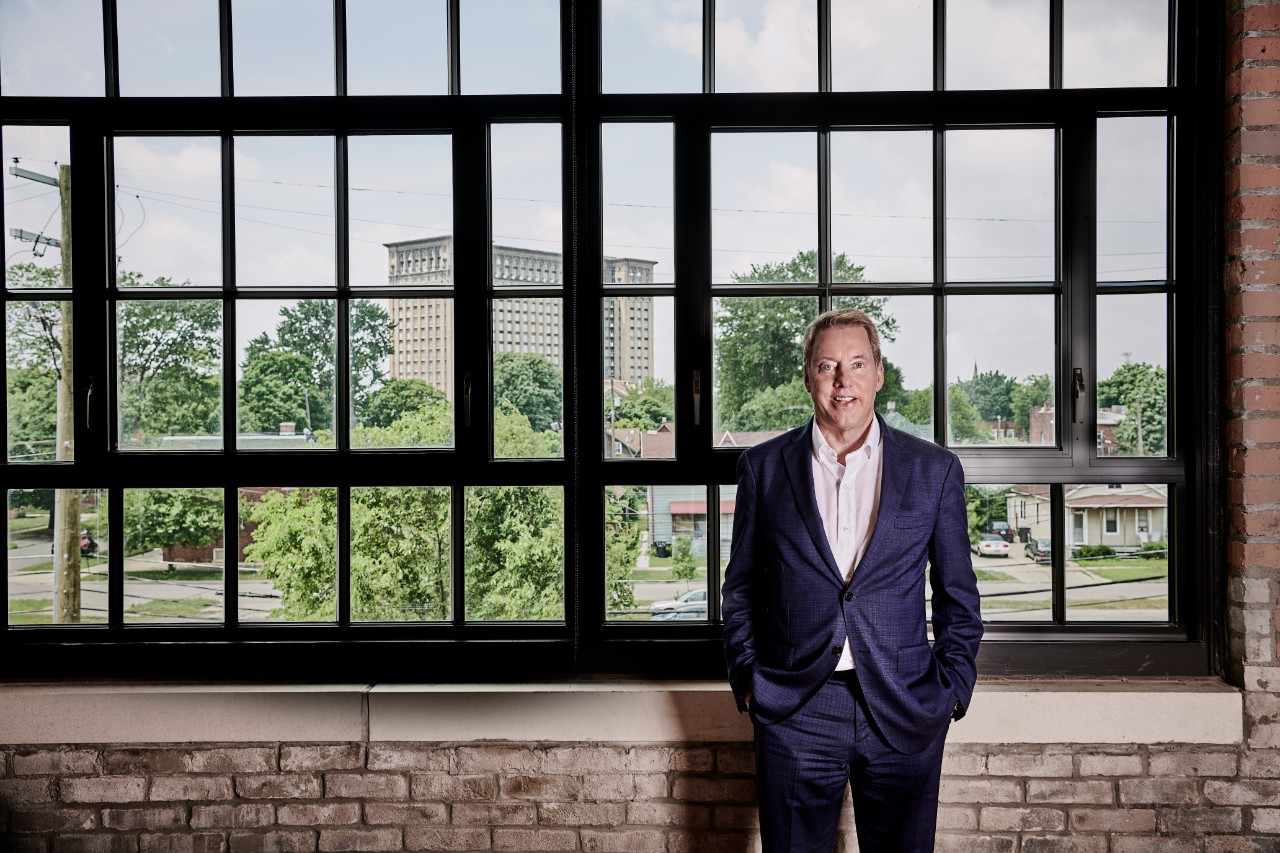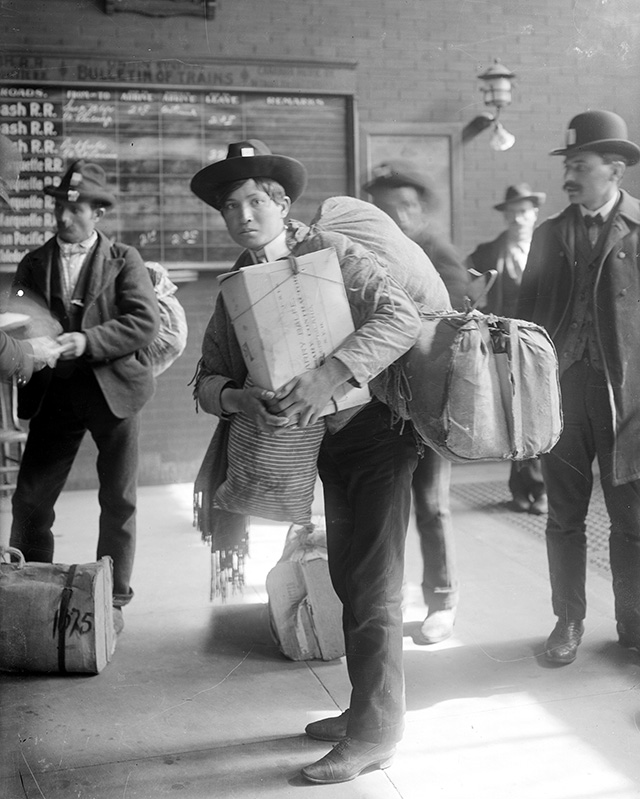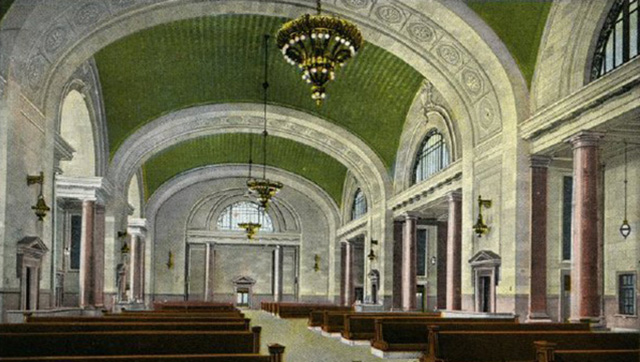
“When the trains pulled into their terminals, the migrants jostled against one another as they began to gather up their belongings. Finally, they filed onto platforms already mobbed with passengers and porters. Many must have paused, unsure of what to do and where to go, then simply decided to follow the flow of people up the stairs to the station’s grand concourses. There they faced for the first time the grandeur of the city …
“Detroit's Michigan Central Station was a Beaux Arts masterpiece, a four-story colonnade dominated by a sequence of ornate arches and glittering chandeliers…
“If they were lucky, the newcomers had friends or relatives waiting; they'd scour the crowds for familiar faces or hope to hear some voice calling their name, some voice they prayed they still might recognize. There would be the moments of reunion, hands outstretched in greeting, the sudden comforts of warm embraces. Others had no one to meet them. How terrifying it must have been to work through the waves of people alone, to step through the terminal's doors and onto the street without a guide .... Detroit's station faced a large park ringed by hotels and boardinghouses and beyond that, Michigan Avenue, the busiest thoroughfare on the city's west side .… All the streets pulsed with energy. Pedestrians, newsboys, shoeshine men, and redcaps crowded the sidewalks. Cabbies jockeyed for fares. Automobile horns blasted as drivers battled for places at the curb. Streetcars clanged by, jammed with riders. In the clamor, no one paid attention to a colored man or woman standing alone, wondering where to go and how to make his way in a new America.”
- From Kevin Boyle's biography of Dr. Ossian Sweet, Arc of Justice.
Opened in late 1913 at Michigan and West Vernor Highway, Detroit’s Michigan Central Station replaced Union Depot, which operated at 3rd and Jefferson from 1884 to 1913.
Michigan Central Station was built about ¾ of a mile west of downtown with the hope that it would anchor additional development, which would be bolstered by increased trade with Canada through a 2.5-mile-long rail tunnel below the Detroit River. Warren & Wetmore, the architects behind New York’s Grand Central Station, designed the Michigan Central in Beaux Arts Classic style. The depot’s two-story entrance hall featured a spacious waiting room, 97 feet wide by 230 feet long, which led to a grand concourse featuring marble columns and a five-story-high domed ceiling.
In its heyday, Michigan Central saw more than 200 trains leave each day and lines stretched from the boarding gates to the main entrance. When visiting Detroit, Presidents Herbert Hoover, Harry S. Truman, and Franklin D. Roosevelt, actor Charlie Chaplin, artists Diego Rivera and Frieda Kahlo, and inventor Thomas Edison disembarked at the depot. Thousands of Detroit-bound black and white Southerners also traveled by train to Michigan Central Station, hoping to find jobs in the city. A post office and mail sorting facility, designed by architect Albert Kahn, was constructed adjacent to the station in 1936. As late as the 1940s, more than 4,000 passengers used the station every day, and more than 3,000 worked in its 18-story office tower.
By the 1950s, passenger train traffic decreased as automobile and air travel offered attractive alternatives to rail transit. Michigan Central Station’s owners attempted repeatedly to sell the facility, beginning in 1956 for one-third of its original cost, but attracted no buyers. The depot’s arcade shops and restaurant closed in 1967. After assuming control of the nation’s passenger rail service in 1971, Amtrak revived the Michigan Central with a $1.25 million renovation program but ultimately chose to close the station in early 1988.
For many years, the station was owned by Manuel “Matty” Moroun, whose business interests also included the Ambassador Bridge that connects Detroit and Windsor, Canada. Over the course of the next three decades, the building fell into disrepair and graffiti covered the walls, as the Station became a symbol of urban decay.
 Bill Ford at MI Central Station
Bill Ford at MI Central Station
In 2018, the Ford Motor Company purchased the Michigan Central site for $90 million. Six years of work, totaling 1.7 million workhours by 3,000 tradespeople at a cost of $950 million, culminated in a June 2024 gala reopening of the station, the centerpiece of a new 30-acre walkable campus for research, development, and testing to produce autonomous vehicles that can accommodate up to 5,000 workers. The City of Detroit restored Roosevelt Park that graces the station’s north entrance, and the adaptive re-use of the two historic structures -- the “Factory” and the “Newlab,”(the former Albert Kahn post office building) -- anchor the campus’s state of the art testing environment. The “Factory” hosts Ford’s autonomous vehicle business and operations team. “Newlab” is an entrepreneurial hub that the company regards as “an open platform concept where everyone from startups to Fortune 500 companies come together to work on solving the world’s mobility challenges and discovering new technology.”
This new innovation hub in Corktown is part of Ford’s plan to reshape the future of global mobility, working with key partners and suppliers and connecting to a broader network of city and regional assets. Executive Chairman Bill Ford believes that “We’re in a war for talent. And some companies feel they have to leave Michigan to go get that talent. Silicon Valley will always be vibrant and always have its fans. But I think there’s also been a level of, I don’t want to say cynicism that exists there now, but it doesn’t have the same spirit and vitality that it did. Everything was possible, it seemed. And I think today that same spirit is here in the city.”
Click to view:
Train Station Will be Place of Possibility Again, a June 2018 Detroit Free Press feature that includes a 45 - image slide show of the history of Ford and the Michigan Central Station, architectural renderings of the completed project, and reports from the ceremony celebrating its rebirth.
Why Ford spent $1 billion to transform an abandoned Detroit train station, a June 2024 feature heralding the gala opening from the national business publication Fast Company. It includes great photos and insights into the vision of Mr. Ford and Detroit Mayor Mike Duggan.
Michigan Central Station Reopens as Heart of a Culture & Tech Hub, The New Michigan Central Station video that opens the Ford website reminds those “who say Detroit is back, that it never left”. The website also offers striking photographs, more detail about the building’s restoration and other facets of the project.
Michigan Central: Future of Global Mobility, This three minute video created by Detroit filmmaker Stephen McGee and poet Jessica Care Moore embodies the creative spirit that Ford has sought to infuse into the fabric of the Michigan Central District.
April Baer's Michigan Public Stateside podcast to listen to a 20 minute interview with the producers of Henry Louis Gates "Great Migration" PBS docuseries. For those who aren't DPTV subscribers and can't access this television broadcast via Passport, this podcast offers insights into why they chose to film this episode at Michigan Central Station.
MICHIGAN CENTRAL STATION & THE CULTURAL COMMUNITIES OF SOUTHWEST DETROIT
 Arrivals at Michigan Central Station (Date Unknown)
Arrivals at Michigan Central Station (Date Unknown)
“Michigan Central means a great deal to us all. In many ways, this building tells the story of our city. This Station was our Ellis Island – a place where dreamers in search of new jobs and new opportunities first set foot in Detroit”, Bill Ford
After having established a strong foundation focusing on the area’s industrial and labor history, the Guide’s tribute to the neighborhood’s auto legacy remains incomplete without shining a spotlight on the people who came from near and far to power the area’s manufacturing operations. In the earliest years of the industry, the single men who comprised the workforce were only guaranteed work during the course of a relatively short production season. As the industry matured over the decades, those workers and their family members who also found work here established the churches, benevolent societies, and small businesses that reflected the cultural heritage of their countries of origin and of America’s Deep South.
The effort to document the history of the African American, Arab, Irish, Italian, Maltese, Native American, Polish and other Eastern European communities will allow the Guide to complete its tribute to the neighborhood. That work is in its early stages and is anchored in the Community History section. To learn more about these efforts, email: This email address is being protected from spambots. You need JavaScript enabled to view it..
TEXT & RESEARCH – DIANNE FEELEY & RON ALPERN




